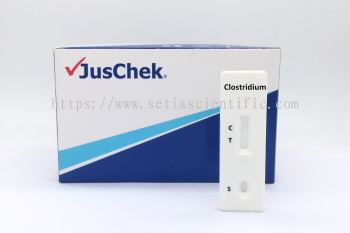Clostridium difficile is an anaerobic bacteria acting as an opportunistic pathogen: it grows in the intestine when the normal flora has been altered by treatment with antibiotics. Toxinogenic strains of Clostridium difficile cause infections from mild-diarrhea to pseudomembranous colitis, potentially leading to death. Disease is caused by two toxins produced by toxinogenic strains of C.difficile: Toxin A (tissue-damaging enterotoxin) and Toxin B (cytotoxin). Some strains produce both toxins A and B, some others produce Toxin B only. The potential role of a third (binary) toxin in pathogenicity is still debated. The use of Glutamate Dehydrogenase (GDH) as an antigen marker of C.difficile proliferation has been shown to be very effective because all strains produce high amount of this enzyme. Clostridium difficile GDH Rapid Test Cassette allows the specific detection of C. difficile's GDH in stool specimen. Samples with a positive result should be investigated further to test for toxigenicity of the bacteria.
��DIRECTION FOR USE��
Allow the test, specimen, stool collection buffer and/or control to equilibrate to room temperature (15-30°C) prior to testing.
1. To process fecal specimens:
For Solid Specimens:
Unscrew the cap of the specimen collection tube, then randomly stab the specimen collection applicator into the fecal specimen at least 3 different sites to collect approximately 50 mg of feces (equivalent to 1/4 of a pea). Do not scoop the fecal specimen.
For Liquid Specimens:
Hold the dropper vertically, aspirate fecal specimens, and then transfer 2 drops of the liquid specimen (approximately 80 µL) into the specimen collection tube containing the extraction buffer.
Tighten the cap onto the specimen collection tube, then shake the specimencollection tube vigorously to mix the specimen and the extraction buffer. Leave the collection tube for reaction for 2 minutes.
2. Remove the test cassette from the foil pouch and use it as soon as possible. Best results will be obtained if the test is performed immediately after opening the foil pouch.
3. Hold the specimen collection tube upright and unscrew the cap of the specimen collection tube. Invert the specimen collection tube and transfer 3 full drops of the extracted specimen (approximately 120µL) to the specimen well (S) of the test cassette, then start the timer. Avoid trapping air bubbles in the specimen well (S). See illustration below.
4. Read the results at 10 minutes after dispensing the specimen. Do not read results after 20 minutes.
5. Note: If the specimen does not migrate (presence of particles), centrifuge the diluted sample contained in the extraction buffer vial. Collect 80 µL of supernatant, dispense into the specimen well (S).of a new test cassette and start afresh following the instructions mentioned above.

|
Cat. No. |
Product Description |
Specimen |
Format |
Kit Size |
Cut-Off |
Status |
|
ICDG-602 |
Clostridium difficile GDH Rapid Test Cassette |
Feces |
Cassette |
10 T |
See Insert |
CE |







 BR 22658
BR 22658  VN 13362
VN 13362  US 5511
US 5511  AR 3787
AR 3787  MY 1563
MY 1563  EC 1471
EC 1471  MX 1331
MX 1331  GB 1250
GB 1250 



